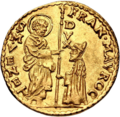Cagliarese
- Machine translation, like DeepL or Google Translate, is a useful starting point for translations, but translators must revise errors as necessary and confirm that the translation is accurate, rather than simply copy-pasting machine-translated text into the English Wikipedia.
- Consider adding a topic to this template: there are already 3,074 articles in the main category, and specifying
|topic=will aid in categorization. - Do not translate text that appears unreliable or low-quality. If possible, verify the text with references provided in the foreign-language article.
- You must provide copyright attribution in the edit summary accompanying your translation by providing an interlanguage link to the source of your translation. A model attribution edit summary is
Content in this edit is translated from the existing Italian Wikipedia article at [[:it:Cagliarese]]; see its history for attribution. - You may also add the template
{{Translated|it|Cagliarese}}to the talk page. - For more guidance, see Wikipedia:Translation.

Cagliarese or callaresito is the name of a series of coins minted at Cagliari (Sardinia).[1]
History
The first Cagliarese, in billon and weighing 0.80 g, was issued by Ferdinand II of Aragon, for a value of two deniers. In the 16th century, under King Charles II, it became in copper.
After the cession of Sardinia to the House of Savoy, the Cagliarese was coined until 1813. Victor Amadeus II minted the 1 and 3 cagliaresi coins, in copper (1720). They sported the profile of the new King, and weighed 2.35 and 6.75 grams, respectively. Victor Amadeus' son, Charles Emmanuel II, added the Mezzo Cagliarese (1⁄2-Cagliarese) also in copper.
After the reformation of 1754, a new Cagliarese in copper, with a weight of 2.34 g and a diameter of 18 mm, was issued.
Under Charles Emmanuel III (1796–1802) the cagliarese was not issued. Victor Emmanuel I issued a 3 cagliaresi coin, around 1813.
The cagliarese disappeared in 1821, when the Scudo (120 Cagliarese) was replaced by the Sardinian Lira, which was divided into 100 centesimi.
Equivalencies to other Sardinian denominations, in 1816
- 2 Denari to the Cagliarese
- 6 Cagliarese to the Soldo
- 30 Cagliarese to the Real
- 120 Cagliarese to the Lira
- 300 Cagliarese to the Scudo
- 600 Cagliarese to the Doppietta
See also
References
- ^ Hazlitt, W.C. (1893). The Coinage of the European Continent: With an Introduction and Catalogues of Mints Denominations and Rulers. Swan Sonnenschein. p. 187. Retrieved 2 July 2018.
Cagliarese, a copper coin of Cagliari, Sardinia, struck by the Kings of Spain as Kings of Sardinia, by the Emperor Charles VI.
- v
- t
- e
 Historic currency and coinage of Italy
Historic currency and coinage of Italy
- Coinage of Cales
- Coinage of Capua
- Coinage of Suessa
- Coinage of the Social War
- Greek coinage of Italy and Sicily
- Etruscan coins
- Roman currency
 Italy portal
Italy portal Category
Category- Economy of Italy
- Economic history of Italy
 | This coin-related article is a stub. You can help Wikipedia by expanding it. |
- v
- t
- e















